<% ns_puts [mkm_getnavbar] %>

Understanding Match Statistics
The Unknown Statistic: The Forced Error
John Yandell
Still Photos by J Gregory Swendsen
|
What can statistics really tell us about tennis matches? What can we learn from the classic Agassi versus Sampras match at this year’s U.S. Open, for example? What about junior and club tennis and all the other levels of the game? What can the average player learn from statistical analysis of his game?
The answer is a tremendous amount. Match charting
allows any player to understand how points are won and lost. It’s
shocking how few players can tell you how they actually win or lose
points. It’s equally shocking how many players have wildly mistaken
notions about how they win or lose points.
Understanding the types of shots and shot patterns
that lead to winning points can revolutionize how you play matches. It’s
even possible to reverse the outcome in long standing rivalries if you
understand what really pays on a percentage basis over the course of a
match.
In this new series we’ll look at what statistics can tell us about how to win matches, starting with an analysis of what I call the “unknown statistic,” the forced error.
The Forced Error
I call forced errors the “unknown statistic,”
because unfortunately they are not recorded by most official tournament
scoring or in TV statistics. Yet it may be the most critical shot
category, and usually decides matches at the pro level, and every level
below.
So what is a forced error? A forced error is a ball which a player has at least the possibility of making a return, is able to execute something approximating a regular swing, but is unable to control and return the shot.The result is an error, but this is different than an unforced error. The error was “forced,” due to the pressure and/or placement of the other player’s ball.
|
A ball that gets by the player entirely or careens off the tip of his racquet is an obvious winner. But when a player has a legitimate swing on a difficult ball, and is unable to put a shot into the court, even if it isn’t a high percentage chance, the point should be scored as a forced error.
To a certain extent, determining a forced error is a
matter of judgment. A ball which forces an error out of one player may
prove no problem for another player, or even an opportunity to attack.
Andre Agassi may handle a big Sampras serve and hit a great return for a
winner. Another player might shank the same ball into the stands.
Or a reverse example: Agassi might hit a big
crosscourt forehand that would be unplayable for most players, creating a
forced error. But Pete might reply with an even stronger crosscourt of his
own—this was at times the case in their Open match, as we shall see.
The forced error is a gray area and varies with the
skill of the players. At times, a ball hit to a player forces an error. At
other times, the same player responding to the same ball manages a reply.
But if you start to watch for them, it possible to recognize what constitutes a forced error at every level of play. This is critical because forced errors usually account for at least 25% and up to 50% or even more of all points.
Agassi vs Sampras
So what did the official statistics tell us about the
Sampras/Agassi match and the role of this critical number? Sadly
nothing!
If you went to the Open website during the event you had access to a seemingly unlimited amount of statistical information. You could generate a statistical report on every match played in every division - men’s, women’s, singles, doubles, junior, and senior events. You could get aces, double faults, winners, errors, net approaches, and serving percentages. You could even study the average serve speeds to all 4 corners of the service box for every player. But not forced errors—and this is true of the television statistics as well.
Another view of course would be to say: "Hey it went to 4 tiebreakers--what effect could the overall stats have had on those--isn't it more important to understand those 4 breakers?" That's shortsighted. In reality the outcome of all matches--even those with multiple tiebreakers--usually depends on what happens in the give and take of the individual points from game to game.
Over 95% of all matches are won by the player who winds the most total points in the match. More than likely the player who has the upper hand over the course of the match, no matter how slim, will come out on top. This is what happened in the Agassi/Sampras match. In fact, Andre's mental let down in the last 3 breakers probably resulted from attrition over long tough battle by a razor thin margin, and Sampras's unexpectedly strong play off the ground. The overall stats really do tell the tale, so let's see how and why.
It turned out that the “forced errors” were the key to understanding this match, as with most matches. So let’s examine why.
|
Let’s start by looking at some of the things the official statistics did tell us. First, the total number of points won by both players. Over 4 tiebreak sets Pete won a total of 173 points. Andre won 161.
That’s a difference of only 12 points over 4 sets!
It means Pete won about one more point than Andre every 4 to 5 games!
Anyone who watched the match saw how close it was and the statistics back
that up.
But what was the difference and how did Pete actually
create that razor thin margin of victory? Here is where the official
statistics fail. It’s impossible to tell. This is because the Open
website and TV coverage report track points won in only 2 categories:
winners and errors.
Let’s see what the official statistics in these two
categories tell us about Agassi/Sampras. If we look at winners, including
aces, Pete had a big edge. In the official numbers, he hit 102
winners—almost 2 clean winners in every game. Agassi hit 73 winners,
about 25% less than Pete.
But Pete’s advantage in total winners was offset by
his unforced errors. Pete had a whopping 51 unforced errors. Agassi only
22.
So let’s total up the official stats on winners and
errors. Pete had 102 winners, and he won 22 more points on Agassi’s
unforced errors. That’s 124 points won by Pete that official stats
account for.
Andre had 73 winners and won 51 points on Pete’s unforced errors. Guess what? That’s also a total of 124 points. 124 points each! Exactly the same number of points for Pete and Andre counting all winners and unforced errors. According to the official statistics it was a dead heat. So what’s going on here?
What the Official Statistics Show |
||
| Pete’s Points Won | Andre's Points Won | |
| Aces | 24 | 18 |
| Winners | 78 | 55 |
| Opponent’s Double Faults | 4 | 12 |
| Opponent’s Unforced Errors | 18 | 39 |
| Total | 124 | 124 |
Note that the points on winners and errors in the
official stats don’t equal the total points won by either player. They
account for only about 75% of the total points played (248 out of 334
points). The remaining 86 points—25% of the total points played--are
unaccounted for. And those 86 points are more 7 times the point margin in
the match.
What the Official Statistics Don’t Show: |
||
| Pete | Andre |
|
| Total Points Won | 173 | 161 |
| Points Accounted For | 124 | 124 |
| Unexplained Points | 49 | 37 |
Although there is no official record, these
unexplained points were presumably decided by forced errors. But without
knowing the real numbers it’s impossible to see the real statistical
difference in the Sampras/Agassi match, or most close matches for that
matter.
|
Without the forced errors, the stats in some pro
matches can even look crazy. The loser can look better statistically than
the winner. For example, one player could hit fewer winners, and make more
unforced errors, butt he could still win the match by creating enough
forced errors, even though the official stats would show him losing in all
categories! I’ve actually seen that in pro match stats from the Open.
So what about those unaccounted points? Were they all unforced errors and what was their actual role in the outcome of Sampras/Agassi match? To find out, I decided to chart the match from scratch from the videotape. The results were surprising in several ways.
At one level, the unforced errors confirmed what most astute observers saw. Andre served better than expected, and Pete played much better off the ground than expected. But they also showed the relative effect of Andre’s serving and Pete’s ground play on the outcome of the match. What the forced errors show was that Andre’s better than expected serving wasn’t enough to offset Pete’s surprising play off the ground. Read on and find out why.
Remember the official match statistics left 86 points
unaccounted for, these presumably were the unrecorded forced errors. The
overall point margin was 12 points in Pete’s favor. So, of these 86
forced errors in the official statistics, 49 would have been forced errors
Pete created, and 37 would have forced errors created by Andre.
The first surprise was that my own charting showed
that the forced errors were higher than the official match
statistics. My totals were 64 forced errors for Pete. This was 15 more
than the official stats. I counted 54 forced errors for Andre. This was 17
more than the official total.
How could this be true? The official stats probably
recorded some shots that I called forced errors as outright winners.
That’s a judgment call, but it also makes sense from the point of view
of the Open, since counting more winners would help account for the
outcome of more points and leave less of a gap in the statistical record.
| Pete | Andre | |
| Official Unaccounted Points | 49 | 37 |
| TennisONE Charted Forced Errors | 64 | 54 |
In any case, my charting showed the forced errors
were probably even more important than what can be inferred from the
official stats. So let’s see how they decided the match.
According to my charting, Pete generated 64 forced errors, i.e., hit 64 shots that were too much for Andre to handle. This was over a third of his entire point total.
|
Andre created 54 forced errors of his own. This was
almost the entire statistical difference in the match--10 more forced
errors generated by Pete. Essentially Pete was able to win by creating 2
or 3 more forced errors per set.
So where did these forced errors come from? One of
the other glaring deficiencies in the Open website official stats is that
the winners and errors are not broken down by strokes. And, of course,
since forced errors aren’t even recorded, they obviously aren’t broken
down by stroke either.
Were the forced errors that decided the match
generated by serves, forehands, backhands, returns, volleys? My charting
showed that most of Pete’s 64 forced errors were generated by his serve,
as you might expect. Pete’s serve alone generated 35 forced
errors, over half his total. In addition, he forced another 13 errors with
his net play.
But the forced errors generated with his serve and
his net game were not enough to win the match by themselves. With his
serve and his volleys, Pete forced 48 errors. That was still less than
Agassi’s total of 54.
The rest of Pete’s forced errors came on his
groundstrokes, his returns, and a few passes. These forced errors
generated by his groundstrokes were the key to match, as we’ll see.
Let’s breakdown Andre’s forced errors. Surprisingly, Agassi generated 18 forced errors with his own serve. But, as you might expect, most of Agassi’s forced errors were generated by the strength of his game, his groundies and returns. He generated 17 forced errors on his groundies, 14 on his returns, and another 6 with passing shots. His forehand was particularly lethal. He created a total of 26 forced errors with his forehand groundies, passes and returns.
Forced Errors |
||
| Sampras | Agassi | |
| Serve | 35 | 18 |
| Forehand | 5 | 14 |
| Backhand | 4 | 3 |
| Forehand Return | 2 | 10 |
| Backhand Return | 3 | 3 |
| Forehand Pass | 0 | 2 |
| Backhand Pass | 2 | 4 |
| Forehand Volley | 8 | 0 |
| Backhand Volley | 4 | 0 |
| Overhead | 1 | 0 |
| Total | 64 | 54 |
During the course of the match, USA commentator John
McEnroe, as well as Sampras’ coach Paul Annacone, stated that Pete
should play more aggressively, i.e., chip and charge, and force the play
at the net on Agassi’s serve. McEnroe harped on it over and over,
pointing out specific balls he felt Pete should attack. Only guest
commentator Todd Martin, who had faced Agassi on the court much more
recently than Mac offered the opinion that Pete was wise to avoid
giving Agassi too many chances to hit those devastating passes.
And the bottom line is, maybe Pete knew something Mac
and his coach didn’t. Pete obviously believed he could stay with Andre
better on the ground than people thought. He obviously thought that was a
better play than constantly attacking the net.
|
More than once Pete stood toe to toe with Agassi from
the baseline and came out ahead. He hit running crosscourt forehands that
surprised and overpowered Andre. And he hit his backhand better and more
aggressively than at any time in recent memory, making several spectacular
backhand returns and backhands down the line.
And the statistics bear this out. Agassi had the edge
from the backcourt, no doubt, but what was surprising was that his margin
in the backcourt was so small over the course of 4 sets.
Agassi created only 17 forced errors off the ground.
Pete created 9 forced errors of his own off the ground. That’s
only 8 points difference over 4 sets!
And Agassi did only slightly better on the returns.
He created 13 forced errors, while Pete created 6. That’s only 7 more
for Agassi, the man with the best return in history, over 4 tiebreaker
sets. And when we break down the outright groundstroke winners, it was
even closer. Andre had 17 outright groundstroke winners to Pete’s 15.
That difference is also surprising.
The numbers are particularly interesting when we look
at the backhand, historically, Pete’s weaker side. Yes, Pete had more
unforced errors on that side—a total of 17 versus only 5 for Agassi. But
at key times in the match, he hit aggressive backhands that won
points—and possibly had a mental impact on Andre, who is on record
saying that the backhand is Pete’s weakness.
If you combine the winners and forced errors, Pete
had a total of 8 points that he won outright with his backhand. That was
actually 2 more than Agassi who only had 6!
So what the stats show is actually quite interesting. Agassi served surprisingly well, but Sampras was even more surprising with his strong play off the ground. What Andre gained with his great serving, Pete more than made up with his success in the groundstroke exchanges.
|
Now don’t misunderstand. Despite Andre’s great
serving, Pete still had a big statistical edge on the serve. And
Andre still won the statistical groundstroke battle. It’s just that
Andre’s statistical margin off the ground was a much smaller margin than
most people expected. In the area where you would expect Andre to make up
the point deficit created by Sampras’ serve, Pete stayed closer than
expected, close enough to make this incredible, incredibly close match
turn in his favor.
So what does this mean for the average player? The
first point is simple awareness. Most players are only focused on their
great shots and bad errors. (Some unfortunately are only focused on the
great shots.) But the average player may not even know what a forced error
is, much less that it often is the critical category in determining who
wins the match.
That brings up the question of shot patterns. What
patterns can you use, not only to hit outright winners, but to pressure
your opponent into unforced errors. And where are your own errors coming
from that are being forced by your opponents? (For more on this see Allen
Fox’s series on Winning
Matches.)
For example, you might make more forehand winners,
but also have more errors hitting crosscourt forehand to forehand against
a given opponent. The backhand crosscourt exchange might be less
spectacular, but it might be easier to force errors there. Remember, a
forced error counts just as much as a winner—you’re one point closer
to winning the match. More on all this as this series progresses.
Next: Another “unknown” statistic: the
aggressive margin. See how winners, unforced errors and forced errors
combine into the “aggressive margin” and the “magic numbers” you
need in this category to win matches at all levels.
Your comments are welcome. Let us know what you think about John Yandell's article by emailing us here at TennisONE.
|
For more information on John Yandell's Advanced Tennis Research Project, click here.
Last Updated 11/1/01. To contact us, please email to: webmaster@tennisone.com
TennisONE is a registered trademark of TennisONE and SportsWeb ONE; Copyright 1995. All rights reserved.

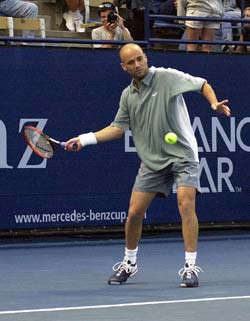
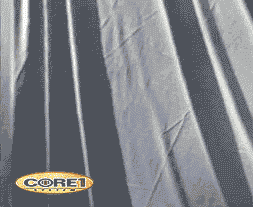
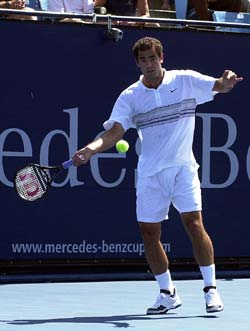
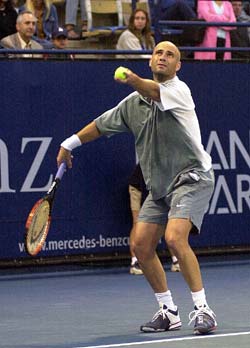
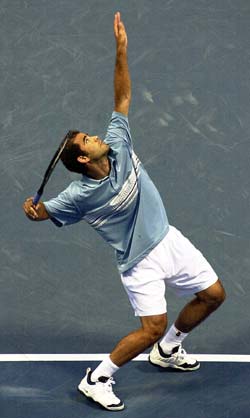
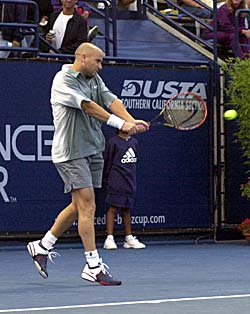
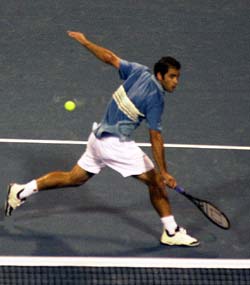
 Visual
Tennis
Visual
Tennis